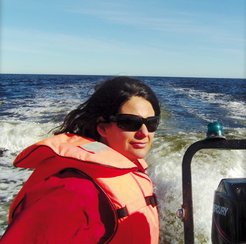Dreaming of a ship of her own
Marine biologist Cecilia Alonso spent a number of years in Europe and returned to Uruguay in 2007. Since then, she sees her home country in a new light, and brings her knowledge and new experiences to research operations there.

When I visit Valizas, a fishing village on Uruguay’s Atlantic coast, I realize that it’s the ebb and flow of the tides that I find most fascinating. Today, only a couple of weathered wooden houses still form the old village core, unoccupied, standing on stilts in the middle of a lagoon, the waters flowing beneath them. It’s been awhile since village life took place in this barren environment, as the residents bowed to the constantly changing coastline a couple of decades ago and moved a few hundred meters northward. That’s just the way it is here - life is determined by the water. And there is little in the new Valizas that is reminiscent of the elemental force of the Atlantic Ocean that once threatened the village.
I returned to my native land on the east coast of South America about seven years ago - I wanted to take a new direction and have an impact. Even back then, I knew that it wouldn’t be all that easy. After all, after completing my doctorate at the Max Planck Institute for Marine Microbiology in Bremen, and a few years in the rich research landscape in Europe, I was a bit spoiled.
Marine research isn’t yet a top priority in South America; it involves a lot of persuasion, a lot of phone calls, a lot of politics. But this, too, is changing. More and more researchers are returning to Uruguay after their studies. And it’s not just knowledge they’re bringing with them.
We’re too demanding, people sometimes say. But actually, many researchers from here are also glad that, because of us, the standards from abroad are slowly starting to become standards here, also. That’s also why we came back, because we want to share the expensive equipment and sophisticated methods with the university, to help shape the change. And the resistance is slowly waning - we are very gradually finding our place. The only thing that remains a dream, for now, is having my own research ship. Then I could travel all by myself to the region where I do my research: the huge Río de la Plata estuary. The change taking place there is enormous.
The nutrient-rich freshwater currents of the Paraná and Uruguay rivers flow steadily into the sluggish, salty Atlantic. Ocean eddies, temperature gradients, sudden salt water - the ecosystem places heavy demands on its inhabitants. However, its tiniest ones, the microorganisms, adapt particularly quickly - and I want to gain an understanding of their lifestyle. Their survival ensures, if you will, that also the fishermen in Valizas can continue to put dinner on the table.
That’s why, here in Uruguay, outreach programs with the communities are very important. Together with those living on the coast, we then take water samples and talk about environmental protection. But to be honest, I’m the one who learns the most there - especially when the older folks wax nostalgic about how things used to be, telling stories about the old Valizas with its handsome wooden houses that are now found only in the lagoon, weathered and moldy. But if I think about it more, there are also some village inhabitants in Valizas who are adapting quite well to the change: the children. For them, the lagoon is simply a great summer playground.












